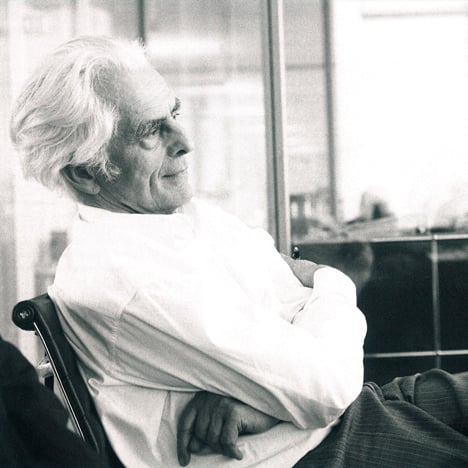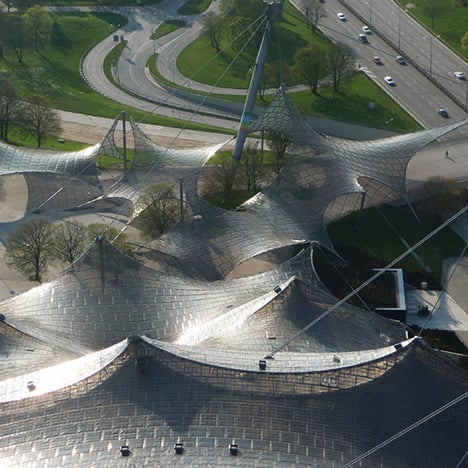
Frei Otto posthumously named 2015 Pritzker Prize laureate
German architect Frei Otto, who died on Monday aged 89, has been named the 2015 Pritzker Prize laureate.
Otto was posthumously awarded the world's richest architecture prize for "his visionary ideas, inquiring mind, belief in freely sharing knowledge and inventions, his collaborative spirit and concern for the careful use of resources," the prize jury announced.
Best known for his cable-net structures built for the 1972 Munich Olympics, Otto died two weeks before he was due to be announced as winner of the prize, causing the Pritzker jury to bring forward the announcement, which was due to be made on 23 March.

"The lessons of his pioneering work in the field of lightweight structures that are adaptable, changeable and carefully use limited resources are as relevant today as when they were first proposed over 60 years ago," the Pritzker jury wrote in their citation.
Tom Pritzker, chairman and president of prize sponsor The Hyatt Foundation said: "Our jury was clear that, in their view, Frei Otto’s career is a model for generations of architects and his influence will continue to be felt."
The jury visited Otto at his home at Warmbronn near Stuttgart before he died and told him he had won the prize, which was due to be awarded at a ceremony in Miami on 15 May.
“I am now so happy to receive this Pritzker Prize and I thank the jury and the Pritzker family very much," Otto said on hearing the news. "I have never done anything to gain this prize."
"My architectural drive was to design new types of buildings to help poor people especially following natural disasters and catastrophes," Otto continued. "So what shall be better for me than to win this prize? I will use whatever time is left to me to keep doing what I have been doing, which is to help humanity. You have here a happy man."
"The news of his passing is very sad, unprecedented in the history of the prize," said Pritzker. "We are grateful that the jury awarded him the prize while he was alive."
He added: "Fortunately, after the jury decision, representatives of the prize traveled to Mr. Otto’s home and were able to meet with Mr. Otto to share the news with him. At this year’s Pritzker Prize award ceremony in Miami on May 15 we will celebrate his life and timeless work."
Modelled after the Nobel Prize, the Pritzker is awarded annually and is widely considered to be the most prestigious award in architecture. It is also one of the biggest financially, providing its winner with $100,000 as well as a bronze medal.
Japanese architect Shigeru Ban received the 2014 prize, and past recipients include Norman Foster, Herzog & de Meuron, Hans Hollein, Peter Zumthor, Oscar Niemeyer and Zaha Hadid.
"Time waits for no man," said jury chair Peter Palumbo. "If anyone doubts this aphorism, the death yesterday of Frei Otto, a titan of modern architecture, a few weeks short of his 90th birthday, and a few short weeks before his receipt of the Pritzker Architecture Prize in Miami in May, represents a sad and striking example of this truism."
Palumbo added: "His loss will be felt wherever the art of architecture is practiced the world over, for he was a universal citizen; whilst his influence will continue to gather momentum by those who are aware of it, and equally, by those who are not. "
The jury for this year's prize included Chilean architect Alejandro Aravena, Australian architect and 2002 Pritzker laureate Glenn Murcutt, British architect and 2007 laureate Richard Rogers, Spanish architect Benedetta Tagliabue, and Chinese architect Yung Ho Chang.
Also among the judges were US Supreme Court justice Stephen Breyer and steel magnate Ratan N. Tata.
The prize ceremony will still go ahead, and will be held in Miami Beach at the New World Centre, designed by 1989 laureate Frank Gehry.
Below is the citation in full:
Frei Otto, born almost 90 years ago in Germany, has spent his long career researching, experimenting, and developing a most sensitive architecture that has influenced countless others throughout the world. The lessons of his pioneering work in the field of lightweight structures that are adaptable, changeable and carefully use limited resources are as relevant today as when they were first proposed over 60 years ago. He has embraced a definition of architect to include researcher, inventor, form-finder, engineer, builder, teacher, collaborator, environmentalist, humanist, and creator of memorable buildings and spaces.
He first became known for his tent structures used as temporary exhibition pavilions. The constructions at the German Federal Garden exhibitions and other festivals of the 1950s were functional, beautiful, "floating" roofs that seemed to effortlessly provide shelter, and then were easily dissembled after the events.
The cable net structure employed for the German Pavilion at Expo 67 in Montreal, prefabricated in Germany and assembled on site in a short period of time, was a highlight of the exhibition for its grace and originality. The impressive large-scale roofs designed for the Munich Olympics of 1972, combining lightness and strength, were a building challenge that many said could not be achieved. The architectural landscape for stadium, pool and public spaces, a result of the efforts of a large team, is still impressive today.
Taking inspiration from nature and the processes found there, he sought ways to use the least amount of materials and energy to enclose spaces. He practiced and advanced ideas of sustainability, even before the word was coined. He was inspired by natural phenomena – from birds’ skulls to soap bubbles and spiders' webs. He spoke of the need to understand the "physical, biological and technical processes which give rise to objects." Branching concepts from the 1960s optimized structures to support large flat roofs. A grid shell, such as seen in the Mannheim Multihalle of 1974, shows how a simple structural solution, easy to assemble, can create a most striking, flexible space. The Mechtenberg footbridges, with the use of humble slender rods and connecting nodes, but with advanced knowledge, produce an attractive filigree pattern and span distances up to 30 meters. Otto's constructions are in harmony with nature and always seek to do more with less.
Virtually all the works that are associated with Frei Otto have been designed in collaboration with other professionals. He was often approached to form part of a team to tackle complex architectural and structural challenges. The inventive results attest to outstanding collective efforts of multidisciplinary teams.
Throughout his life, Frei Otto has produced imaginative, fresh, unprecedented spaces and constructions. He has also created knowledge. Herein resides his deep influence: not in forms to be copied, but through the paths that have been opened by his research and discoveries. His contributions to the field of architecture are not only skilled and talented, but also generous.
For his visionary ideas, inquiring mind, belief in freely sharing knowledge and inventions, his collaborative spirit and concern for the careful use of resources, the 2015 Pritzker Architecture Prize is awarded to Frei Otto.